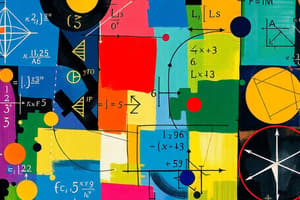Podcast
Questions and Answers
What is the primary purpose of functions in algebra?
What is the primary purpose of functions in algebra?
- To assign a unique output to each input (correct)
- To confuse students with complex rules
- To hide relationships between variables
- To solve geometry problems
In algebra, what do ratios and rates help us compare?
In algebra, what do ratios and rates help us compare?
- Variables and functions
- Mathematical symbols
- Exponents and indices
- Two quantities (correct)
What is the result of the expression $3^2$?
What is the result of the expression $3^2$?
- $12$
- $6$
- $9$ (correct)
- $5$
How does algebra contribute to finding formulas for perimeter, area, and capacity in geometry?
How does algebra contribute to finding formulas for perimeter, area, and capacity in geometry?
Which mathematical concept helps in proving congruence between geometric figures?
Which mathematical concept helps in proving congruence between geometric figures?
What is the formula for finding the area of a circle?
What is the formula for finding the area of a circle?
According to the Pythagorean theorem, what does the square of the hypotenuse equal to?
According to the Pythagorean theorem, what does the square of the hypotenuse equal to?
Which congruence rule states that if three sides of one triangle are congruent to three sides of another triangle, then the triangles are congruent?
Which congruence rule states that if three sides of one triangle are congruent to three sides of another triangle, then the triangles are congruent?
What kind of relationship do laws in geometry describe?
What kind of relationship do laws in geometry describe?
In algebra, what does studying ratios and rates allow us to explore?
In algebra, what does studying ratios and rates allow us to explore?
Flashcards are hidden until you start studying
Study Notes
Algebra: Exploring the Foundations of Mathematical Structure
Algebra, a cornerstone of mathematics, serves as the language and framework for understanding and solving problems involving variables, relations, and structure. In this exploration, we'll delve into four key subtopics that enrich our understanding of algebra: functions, ratios and rates, number operations and indices, and geometry-related concepts like perimeter, area, and capacity, Pythagorean theorem, laws, and congruence.
Functions
A function is a rule that assigns a unique output (y-value) to each input (x-value). Functions are central to algebra because they model relationships and provide a framework to analyze and solve problems. Common functions include linear, quadratic, and exponential functions.
Ratios and Rates
Ratios and rates are expressions that compare two quantities. For instance, ratios can help us find proportions, while rates describe how one quantity changes relative to another over time. For example, the speed of a car is its rate of change in position over time.
Number Operations and Indices
Algebraic expressions involve performing operations on numbers, variables, and their exponents. Understanding exponents is fundamental to algebraic manipulation. For instance, the expression (2^3) means multiplying 2 three times, which equals 8.
Perimeter, Area, and Capacity
In geometry, we use algebra to find formulas for perimeter, area, and capacity. These concepts help us calculate the properties of shapes like rectangles, circles, and cylinders. For example, to find the area of a circle, we use the formula (A=\pi r^2), where (r) is the circle's radius.
Pythagorean Theorem, Laws, and Congruence
The Pythagorean theorem states that in a right-angled triangle, the square of the length of the hypotenuse (the side opposite the right angle) is equal to the sum of the squares of the lengths of the other two sides. This theorem is a fundamental foundation of algebra and geometry.
In geometry, we also learn about congruence and laws. Congruence refers to figures that are the same size and shape, while laws describe relationships between corresponding parts of congruent figures. For example, the Side-Side-Side (SSS) congruence rule states that if three sides of one triangle are congruent to three sides of another triangle, then the triangles are congruent.
In summary, algebra extends beyond its initial conception as a tool for solving equations. It serves as the gateway to an array of mathematical concepts and applications. Studying algebra allows us to explore the nuances of functions, ratios and rates, number operations and indices, and geometry-related concepts like perimeter, area, and capacity, Pythagorean theorem, laws, and congruence. These skills are essential not only in mathematics but also in science, engineering, and beyond.
Studying That Suits You
Use AI to generate personalized quizzes and flashcards to suit your learning preferences.




